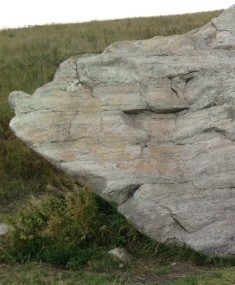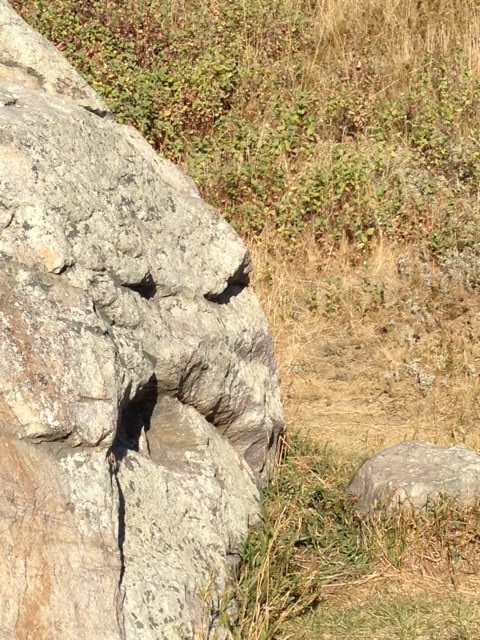When Buffalo Rubbing Stones Talk
A Profile of Split Rock, the Nose Hill Park Buffalo Rubbing Stone and the Paskapoo Slopes Erratic
August 2020
By Dr. Sami A. Houry
This is the third article in the series “When Buffalo Rubbing Stones Talk”. In the previous articles glacial erratic boulders were introduced. The articles described how a rockslide at the Rocky Mountains resulted in the boulders landing on a tongue of glacial ice. The glacier then transported the boulders to the prairies where they were ultimately deposited at the end of the ice age. Specific erratics were also discussed, such as Big Rock west of Okotoks and the Panorama Hills Buffalo Rubbing Stone, also known as Crater Rock.
In this article we profile three additional erratics in the Calgary area. One in the Northern Hills Community of Harvest Hills, known as Split Rock which sits in Confluence Park. Another is in nearby Nose Hill Park, known as the Nose Hill Park Buffalo Rubbing Stone, and the third is the Paskapoo Erratic on the Paskapoo Slopes next to the WinSport Canada Olympic Park. The child in the accompanying pictures of the erratics is intended as a compositional element to provide a sense of scale.
1.0 Split Rock
Split Rock lies in Confluence Park, also known as West Nose Creek Park (Figure 1a). It is accessible by hiking the park’s trails east of Harvest Hills Blvd. According to Google Maps, the GPS coordinates are (51.134010, -114.066005). Based on the Confluence Park information display, Split Rock is a prime example of an erratic that was split in the near middle by the expansion of freezing water in its crevices every winter season, hence its name.
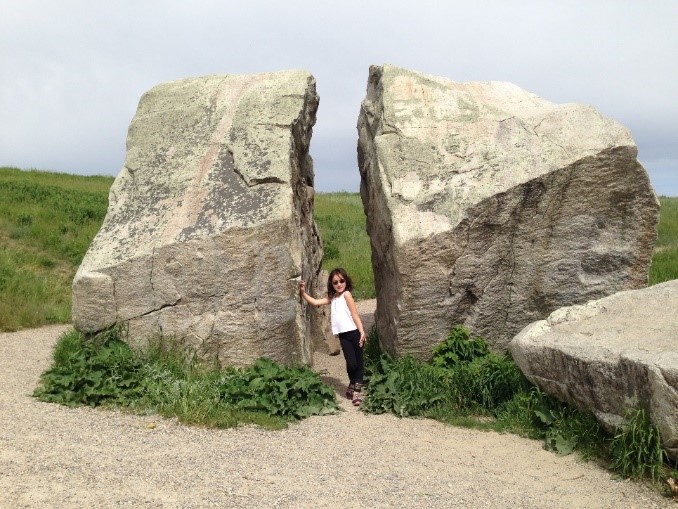
© Dr. Sami A. Houry. June 2017.
Other pieces of the erratic also lie next to the two main split sections (Figures 1b and 1c). Its obvious quartzite composition is the signature of its origin from the mountains near Jasper. Unfortunately, despite the erratic’s presence in a City park it has been subjected to numerous graffiti over the years as evident in Figures 1b and 1c.
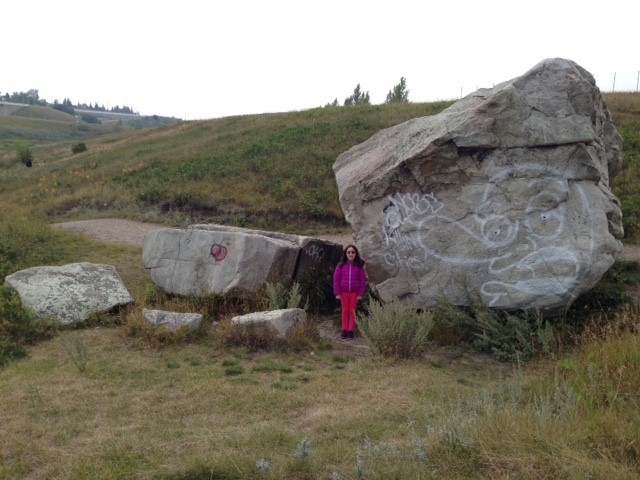
© Dr. Sami A. Houry. Aug 2018
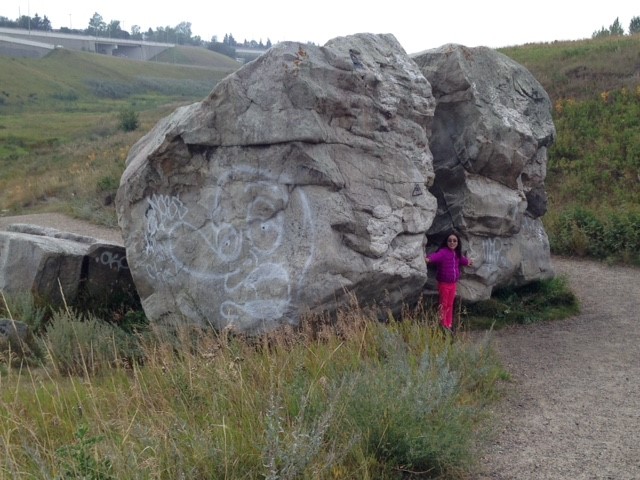
© Dr. Sami A. Houry. Aug 2018
The image of Split Rock along with a buffalo rubbing against is the currently adopted logo for Confluence Park as evident in park signage (Figure 1d). This harkens back to its utility as a buffalo rubbing stone that helped buffaloes shed their winter coats or relief an itch from springtime’s mosquito bites. The rubbing action ultimately smoothed sections of the rock’s surface.
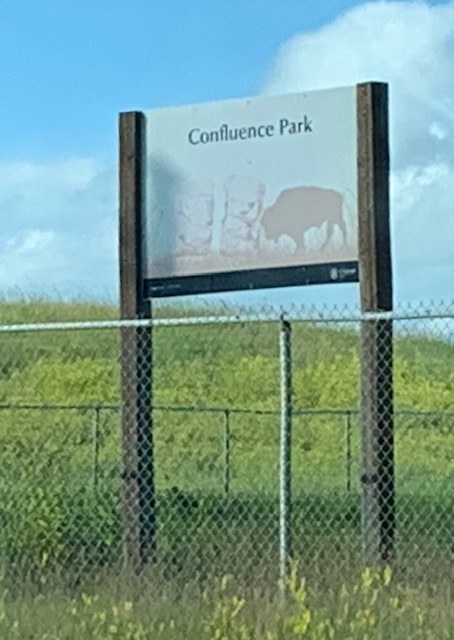
© Dr. Sami A. Houry. July 2020
2.0 The Nose Hill Park Buffalo Rubbing Stone
Nose Hill Park, Calgary’s large municipal park, has a Buffalo Rubbing Stone visible to northbound and southbound commuters along 14th Street in the city’s northwest quadrant (Figure 2a). The rock is accessible by hiking west on the trails starting from the 64th avenue Nose Hill Park entrance. According to Google Maps the GPS coordinates are (51.111912, -114.090804).
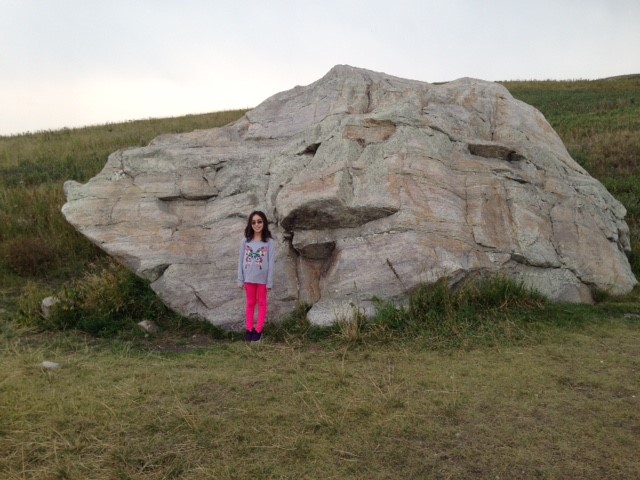
© Dr. Sami A. Houry. August 2018
Interestingly, the rock has the profile of a nose when viewed from one angle adding one more possibility to the list of theories as to why Nose Hill Park was named as such (Figure 2b). The rock also has the profile of a buffalo’s head when viewed from another angle (Figure 2c). This is likely a consequence of pareidolia whereby the human eye tends to identify a familiar shape in random patterns. The pareidolia is likely triggered by the name of the park “Nose Hill” and/or the rock’s utility as a “buffalo rubbing stone”. Nevertheless, this does not take away from the rock’s allure to Nose Hill Park hikers and children who are often spotted scaling the rock to the top to enjoy panoramic views of the park and Calgary’s international airport to the east.
Right-Figure 2c: Profile of a Buffalo Head © Dr. Sami A. Houry. September 2017
Unfortunately, the Nose Hill Park Buffalo Rubbing Stone has also been subjected to disrespectful graffiti over the years (Figure 2d).
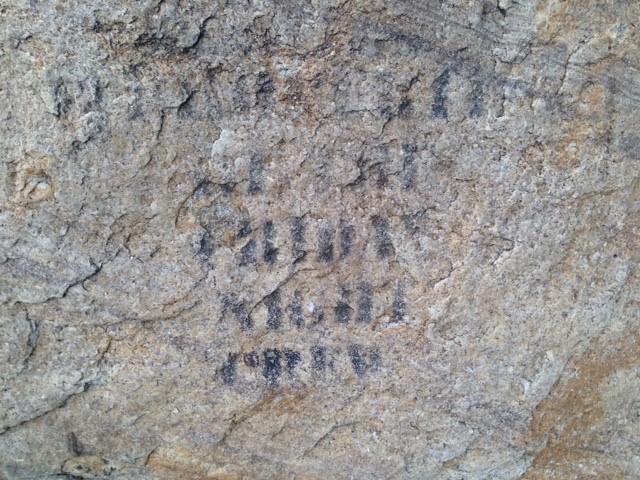
© Dr. Sami A. Houry. August 2018
3.0 The Paskapoo Slopes Erratic
The Paskapoo Slopes Erratic, also known among locals as Big Rock, is not to be confused with its giant cousin, the Big Rock of Okotoks. The erratic was deposited on the Paskapoo Slopes overlooking 16th Avenue, near WinSport’s Canada Olympic Park (Figure 3a).
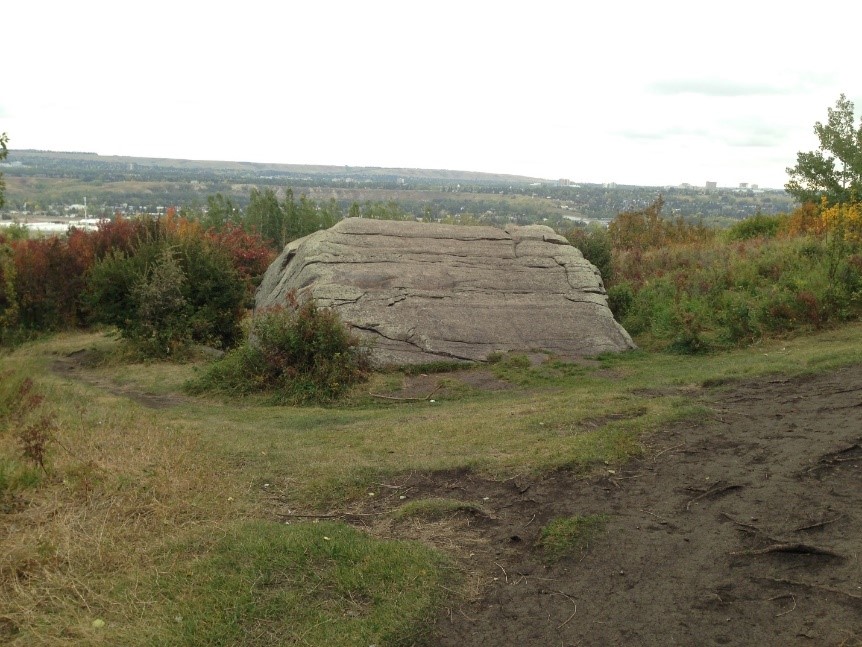
© Dr. Sami A. Houry. September 2018
4.0 Closing
The presence of the three erratics in Calgary parks affords them a level of protection. Perhaps the Northern Hills community of Coventry Hills could advocate for the preservation of its own Beddington Erratic in a park in the Nose Creek Valley.
This article is one in a series of articles intended to raise awareness of glacial erratic boulders and more specifically to advocate for the protection of the Beddington Erratic, along with its natural crater, in Calgary’s Northern Hills community of Coventry Hills. The Beddington Erratic lies between the Canadian Pacific Railway tracks and Nose Creek in the soon to be developed Nose Creek Valley, at the eastern edge of Coventry Hills. If you wish to advocate for the protection of the Beddington Erratic in its natural crater please email advocacy@nhca.ca.
References:
Information Plaque. Split Rock in Confluence Park. Accessed 2017.
Natural Resources Canada. (2010). Retrieved July 23, 2020 from
http://weblex.nrcan.gc.ca/html/011000/GSCC00053011571.html
Revised Stoney Industrial Area Structure Plan. (2014). The City of Calgary. Retrieved May 27,
2020 from
Stalker A. (1956). The Erratics Train Foothills of Alberta. Geological Survey of Canada. Bulletin
37. Department of Mines and Technical Surveys.
A Profile of the Panorama Hills Erratic
By Dr. Sami A. Houry
July 2020
The community of Panorama Hills in the northwest quadrant of the city has one of Calgary’s largest erratics (Figure 1). The rock sits in a small park within a residential neighborhood accessible by turning from Country Hills Blvd. onto Panorama Hills Way. According to Google Maps, the GPS coordinates are (51.151863, -114.070207).
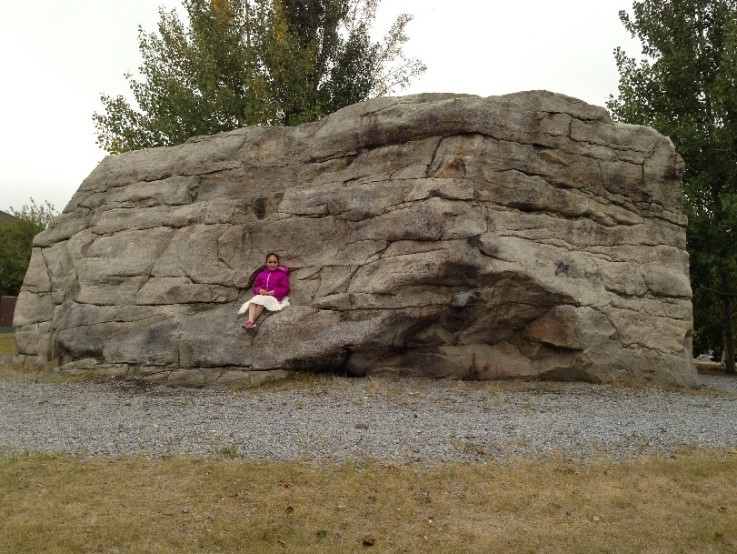
© Dr. Sami A. Houry. September 2017.
Based on an information plaque installed by Genstar Development Company, this quartzite erratic was part of a rockslide which occurred near Jasper-Alberta around 18,000 years ago. The erratic settled on an eastward moving glacier which in turn collided with the Laurentide ice sheet diverting it to a southeastern direction. At the end of the ice age the glaciers receded depositing this and other erratics in a corridor running from Jasper to Northern Montana. The 644 km corridor is known as the Foothills Erratic Train.

© Dr. Sami A. Houry. September 2018.
The smoothness of the erratic’s surface is a reminder of its utility as a buffalo rubbing stone. The erratic is also known as Crater Rock as it originally lay in a depression prior to the development of Calgary’s northwest community of Panorama Hills. According to Stalker (1956), the crater-like depression is believed to have been created by the buffaloes rubbing against the erratic to shed their winter coats or to relieve an itch. The Buffaloes, upon stomping the ground and loosening the soil, picked up the dust on their coats and carried it offsite with them. The loosened ground soil could also have been blown off by the wind.
In 2017 the community of Panorama Hills named its second elementary school “Buffalo Rubbing Stone School” in recognition of the significance of the erratic as a local landmark (CBE, 2020) (Figure 2).
The erratic has undoubtedly undergone some transformation over the years. Based on a 1956 photo by the Geological Survey of Canada, which predates the development of the Panorama Hills community (Figure 3), the erratic was described as having the dimensions of 31 x 23 x 11 feet, weighing 500 tons and sitting in a 7 foot deep depression, which is why it was known as crater rock (Stalker, 1956).
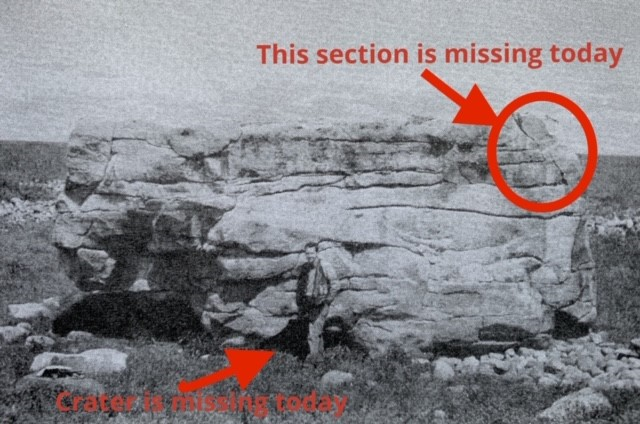
Source: Geological Survey of Canada. Bulletin 37 (1956). Department of Mines and Technical Surveys.
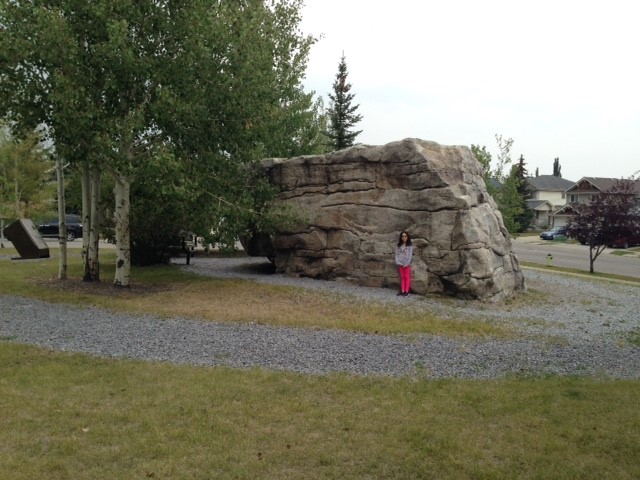
© Dr. Sami A. Houry. August 2018.
Comparing this information with a modern-day photo of the erratic from 2018 (Figure 4), it is evident that the erratic has gone through some changes over the years as it has lost a portion of its top right corner. Therefore, it likely weighs less today. More interestingly, the erratic currently sits on level ground as opposed to a depression. This likely occurred during the development of the residential community. The loss of the crater is an unfortunate loss of an ecological signature that harkens back to a time when buffaloes roamed the prairies in the millions rubbing against the erratics.
Another point of concern is the graffiti that the erratic is subjected to every now and then (Figure 5). It is worth pointing out that “Big Rock” west of Okotoks has Blackfoot pictographs (Goodenough, 2014). It is unclear whether other smaller erratics, such as the Panorama Hills Erratic, also exhibit them. Until further studies are undertaken the presence of such graffiti on the surfaces could be a cause of some potential damage. The presence of graffiti is also disrespectful to the Panorama Hills’ cultural and geological community landmark.
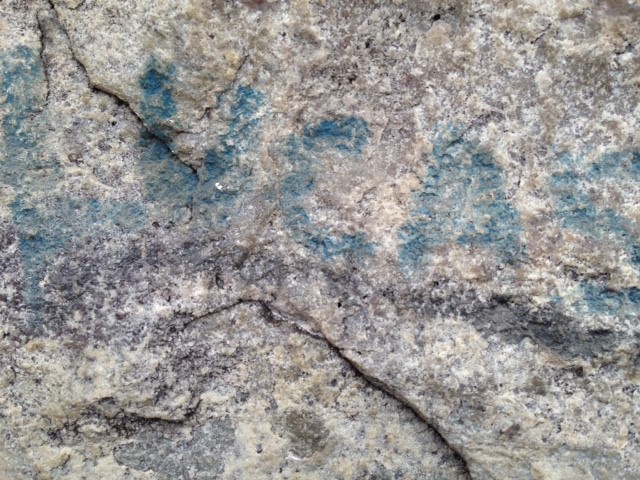
© Dr. Sami A. Houry. August 2018.
In all, the community of Panorama Hills has done well preserving its erratic, creating a small park around it, recognizing it as a community landmark, and naming an elementary school after it. Perhaps the neighboring community of Coventry Hills could do the same by preserving its own erratic in the Nose Creek Valley.
This article is one in a series of articles intended to raise awareness of glacial erratic boulders and more specifically to advocate for the protection of the Beddington Erratic, along with its natural crater, in Calgary’s Northern Hills community of Coventry Hills. The Beddington Erratic lies between the Canadian Pacific Railway tracks and Nose Creek in the soon to be developed Nose Creek Valley, at the eastern edge of Coventry Hills. If you wish to advocate for the protection of the Beddington Erratic in its natural crater please email advocacy@nhca.ca.
References:
Calgary Board of Education. Buffalo Rubbing Stone School. (2020). Webpage. Retrieved June 21, 2020, from http://school.cbe.ab.ca/school/buffalorubbingstone/aboutus/school/pages/default.aspx
Goodenough, R. (2014). Okotoks Big Rock-Managing Vandalism with Technology. RETROactive Exploring Alberta’s Past. Retrieved May 27, 2020, from Okotoks Big Rock – Managing Vandalism with Technology.
Information Plaque. Genstar Development Company. Accessed 2018.
Revised Stoney Industrial Area Structure Plan. (2014). The City of Calgary. Retrieved May 27, 2020, from https://www.google.ca/url?sa=t&rct=j&q=&esrc=s&source=web&cd=&ved=2ahUKEwiJ2P3MzNPpAhVBCTQIHWIIBgIQFjABegQIAxAB&url=http%3A%2F%2Fpublicaccess.calgary.ca%2Flldm01%2Flivelink.exe%3Ffunc%3Dccpa.general%26msgID%3DBTTrAeeeyTG%26msgAction%3DDownload&usg=AOvVaw2etgOPsw7U6eoqEDo_Hg1o
Stalker A. (1956). The Erratics Train Foothills of Alberta. Geological Survey of Canada. Bulletin 37. Department of Mines and Technical Surveys.
When Buffalo Rubbing Stones Talk
Alberta’s Glacial Erratic Boulders
June 2020
By Dr. Sami A. Houry
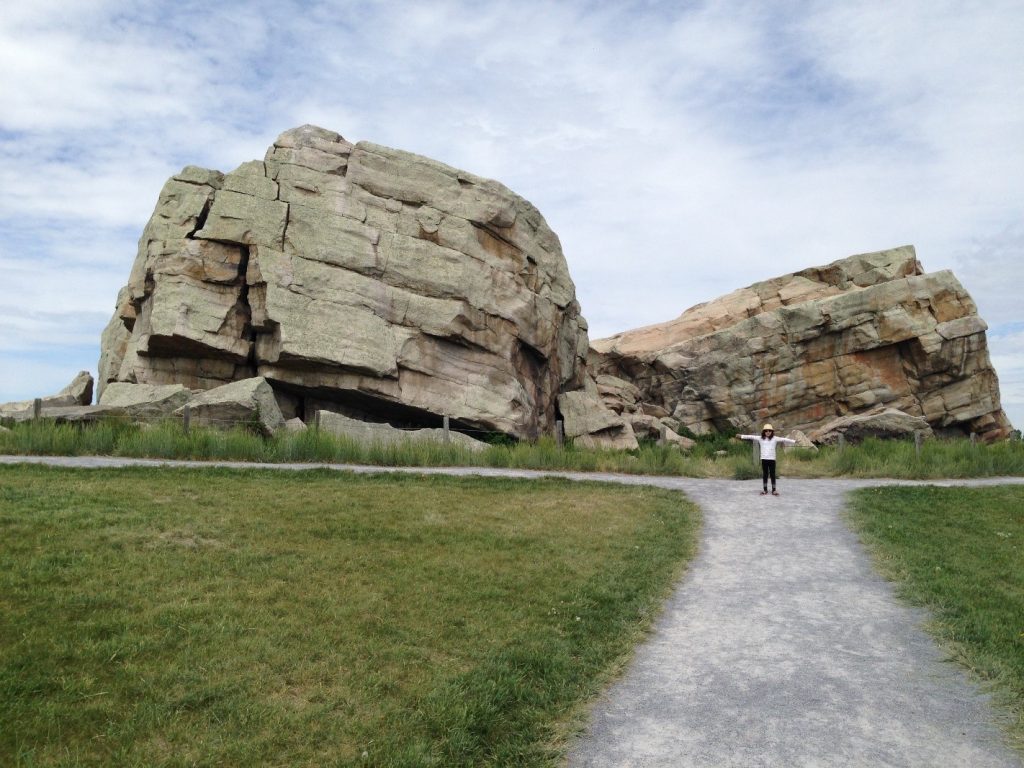
The prairies along the foothills of southern Alberta are home to rocks that differ compositionally from other rocks in their local environments. The oddness of these rocks, which can range in size from fieldstones to large boulders, is given away by their quartzite composition. Plaques erected near some of these rocks explain that they have journeyed many miles during the ice age, originating from the Canadian Rockies when they first broke off from Mount Edith Cavell near Jasper in a rock slide and landed on the Cordilleran ice sheet. The ice sheet’s slow movement provided the rocks with a convenient mode of transportation from the mountains, through the foothills and onto the prairies. When the glaciers receded the rocks were deposited on the prairies creating what is now known as the foothills erratics train, where the Cordilleran and the Laurentide ice sheets once met. This is a 930 km stretch on which many Alberta communities such as Okotoks and the city of Calgary are incidentally positioned today. Such rocks are scientifically referred to as “Glacial Erratic Boulders”. An appropriate name indeed as the word erratic, according to vocabulary.com, comes from the Latin verb “errare” meaning “to wander” off course.

These Stonehenges of the prairies are also known by other names. When buffaloes roamed the prairies in the millions, they opportunistically rubbed against the boulders to shed their winter coats in the spring or to relieve an itch. Their actions smoothed and polished some of the erratics’ surfaces earning them the moniker “Buffalo Rubbing Stones”. According to Stalker (1956), dust stirred up by the weight of the rubbing buffaloes’ hooves either landed on their hides and was carried with them off site or was blown off by the wind. This resulted in the creation of crater-like depressions around some erratics. The erratics are therefore not only of geologic and ecologic interest but also of cultural significance to Indigenous peoples who relied on the buffalo hunt for sustenance.
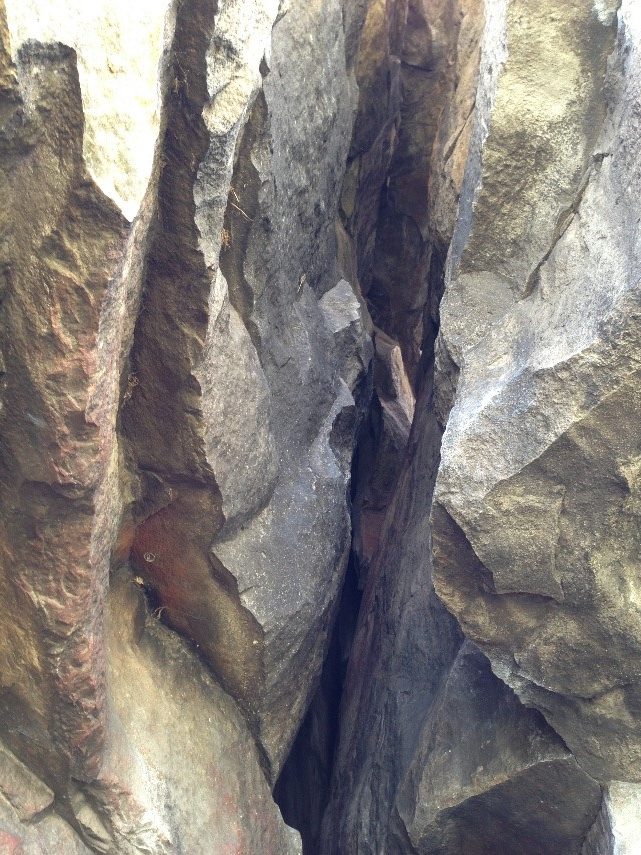
The erratics’ historical and cultural significance is evident by the pictographs present on one of the largest erratics in North America known as “Big Rock”. This erratic lies to the west of the town of Okotoks, has Blackfoot ochre pictographs and is the site of Blackfoot ceremonies (Goodenough, 2014). In addition, it is associated with Blackfoot legends. For example, although the split in Big Rock is attributed to natural processes, an information plaque next to the erratic narrates a legend recorded by the ethnographer George Bird Grinnell in the nineteenth century which provides the cultural version as to why the Rock was split in two. The legend states:
“One hot summer day, Napi-the supernatural Trickster of the Blackfoot-sat upon the Rock to rest. Because it was so hot, Napi threw his robe over the Rock saying ‘Here, I give you my robe, because you are poor and have let me rest on you. Keep it always.’ Napi walked on, and it began to rain. Napi sent to the Rock and asked it to lend him the robe, but the Rock refused. Napi got angry and took ‘his’ robe. As he walked away, he heard a loud noise-The Rock was chasing him!
Napi was scared and ran. His friends – the buffalo, the deer, and the antelope – tried to stop the Rock but were crushed. Nearly exhausted, Napi called upon some bats for help. The bats dove at the Rock and one hit it in the middle and split it in two.”
Despite their historical and cultural significance, erratics have not received their fair share of recognition as heritage resources. For example, although Big Rock stands on a provincial historic site and despite the fencing around it, rock climbers continue to exercise on the rock and other visitors have left random graffiti on it, not to mention the shards of glass from beer bottles within the surrounding perimeter. Furthermore, other erratics on the prairies were lost entirely when they were cleared off lands for building roads or agriculture. There is a serious lack of law enforcement although they are worthy of preservation.
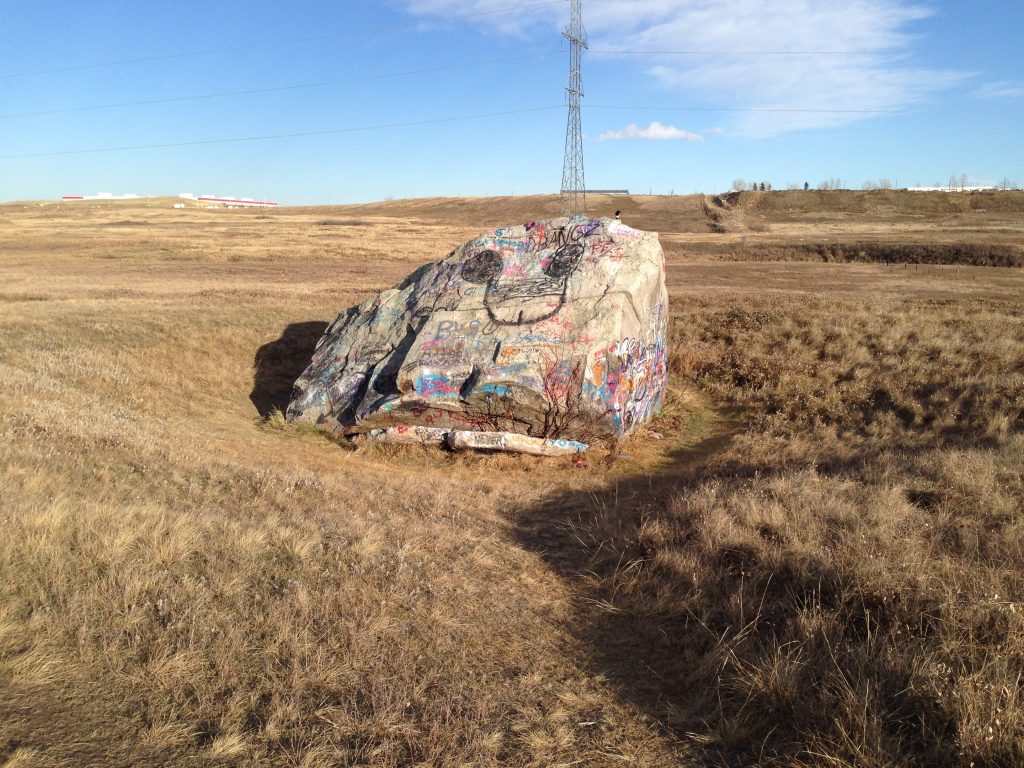
To this end, a series of articles will be released in the coming issues of the Northern Hills News to provide a general synopsis along with a photographic profile of some of the notable erratics within the city of Calgary, including some in Northern Hills communities. This is intended to raise awareness of the erratics and more specifically to advocate for the protection of the Beddington Erratic, along with its natural crater, in Calgary’s Northern Hills community of Coventry Hills. The Beddington Erratic lies between the Canadian Pacific Railway tracks and Nose Creek in the soon to be developed Nose Creek Valley, at the eastern edge of Coventry Hills. If you wish to advocate for the protection of the Beddington Erratic in its natural crater please email advocacy@nhca.ca.
Sources:
Goodenough, R. (2014). Okotoks Big Rock-Managing Vandalism with Technology. RETROactive
Exploring Alberta’s Past. Retrieved May 27, 2020 from Okotoks Big Rock – Managing Vandalism with Technology
Information Plaque. Big Rock. West of Okotoks. Accessed 2017.
Okotoks Erratic-Big Rock. (2020). Homepage. Retrieved May 27, 2020 from
https://www.alberta.ca/okotoks-erratic-big-rock.aspx
Revised Stoney Industrial Area Structure Plan. (2014). The City of Calgary. Retrieved May 27, 2020
https://www.google.ca/urlsa=t&rct=j&q=&esrc=s&source=web&cd=&ved=2ahUKEwiJ2P3MzNPpAhVBCTQIHWIIBgIQFjABegQIAxAB&url=http%3A%2F%2Fpublicaccess.calgary.ca%2Flldm01%2Flivelink.exe%3Ffunc%3Dccpa.general%26msgID%3DBTTrAeeeyTG%26msgAction%3DDownload&usg=AOvVaw2etgOPsw7U6eoqEDo_Hg1o
Stalker A. (1956). The Erratics Train Foothills of Alberta. Geologic Survey of Canada. Bulletin 37. Department of Mines and Technical Surveys.
Vocabulary.com. (2020). Homepage. Retrieved May 27, 2020.

